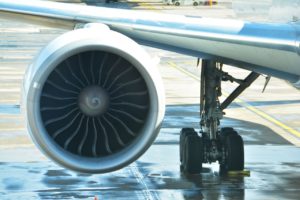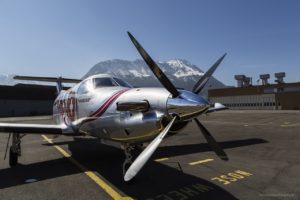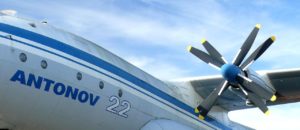What Are the Different Types of Jet Engines?
We explore the different types of jet engines used in Aircraft such as gas turbines, turbofans, turbojet, turboshaft, ramjets, and scramjets.
Posted: September 12, 2017
By:
Types of Engines Used in Aircraft
Most aircraft are powered by some form of air-breathing jet engine. These engine systems draw in air that is compressed, combusted, and expelled to produce thrust. The thrust may come from high-pressure exhaust, or from rotating turbine blades that drive external components.
Gas Turbine Engines
The most common aircraft engine designs are gas turbines. Gas turbine engines suck in air that is mixed with fuel and ignited to produce hot, expanding gas. The energy of the expanding gas is used to power a turbine – a wheel of airfoils or blades that spins around an axle to drive engine components like propellers and fans. There are different types of gas turbine engines used in modern aircraft, all powered by spinning blades and burning air.
 Turbofan:
Turbofan:
Turbofan engines are the most common for commercial jetliners, as they offer substantial thrust and high fuel efficiency. These engines are easily identifiable by the large fan at the front, used to draw in massive volumes of air.
Fun fact: During takeoff, a typical airline engine can take in over one ton of air per second.
Some of this intake air is channeled into the engine core for combustion, while some is diverted around the combustor to be expelled directly from the nozzle.
Types of Turbofan Engines
Turbofan engines can be classified into two variants based on the ratio of bypassed air.
- High-bypass turbofan engines divert most of the air around the combustor to be expelled directly from the nozzle as thrust-producing exhaust.
- Low-bypass turbofan engines channel more intake air through the various engine stages, producing greater thrust via combustion but also consuming more fuel.
Turbojet:
Turbojet engines are an earlier variation without the large frontal fan. They were the first gas turbines for aviation. Turbojets draw air directly into the compressor, and all the hot air passes through the combustor and turbine stages before exiting via the propelling nozzle. Turbojet engines are a relatively simple and compact design, but lack the fuel-efficiency and noise-reducing benefits of a high-bypass turbofan.
Fun fact: Turbojet engines powered the Concorde – a since-retired supersonic passenger jet that was capable of flying twice the speed of sound.
Turboprop:
A turboprop engine is essentially a turbojet with a propeller attached. Intake air passes through a compressor and combustion chamber, then the combusted gas is used to drive a rotating turbine. The turbine shaft is connected to a propeller outside the engine, which spins to create thrust that propels the plane forward. Propeller power and thrust power of this jet engine are balanced for optimal performance. Turboprops provide limited airspeed, but are very efficient – making them popular with smaller commercial and private aircraft.
Fun fact: The world’s largest turboprop aircraft, the Antonov An-22, is powered by four pairs of contra-rotating propellers that spin in opposite directions to balance torque.
Turboshaft:
Turboshaft engines are like turboprops in that the airflow is harnessed to drive a rotating turbine to produce power. The main difference is that a turboprop directly rotates the propeller to produce thrust, while the turboshaft usually drives a transmission that in turn powers the aircraft. Turboshaft engines are most common in helicopters, where the turbine shaft connects to a transmission that powers the helicopter rotors. Turboshafts are also commonly used in tanks, trains, and ships.
Ramjet and Scramjet
Ramjets are airbreathing combustion engines, but differ from gas turbines because they have no rotating blades or moving parts. Ramjets operate on the same principles of compression, combustion, and exhaust, but rely solely on the forward motion of the aircraft to compress incoming air. Ramjets are inefficient at low speeds, but can accelerate aircraft to supersonic levels, making them popular for fighter jets and missiles.
Scramjets operate on similar principles, but achieve even higher velocities by combusting supersonic air within the engine core. NASA utilized a scramjet to accelerate an unmanned aircraft to nearly 7,000 miles per hour – a world record at ten times the speed of sound.
Critical Component Enhancement
Aircraft engines are among the most sophisticated systems ever created. These modern marvels of jet engines harness energy from air to lift massive loads, pierce the stratosphere, and surpass the speed of sound. In addition to being complex and powerful, jet engines are exceptionally reliable – delivering millions of passengers safely to their destination each day.
Laser peening plays a critical role in engine performance and reliability for different types of airplane engines, allowing engineers to push the envelope while ensuring maximum safety. All gas turbine engines are susceptible to metal fatigue or stress cracking in the rapidly spinning blades. If a single blade fails during engine operation, it can damage or disable the entire system, putting the aircraft, passengers, and crew in jeopardy. Metal fatigue has played a deadly role in several high-profile aviation disasters, and blade failure has contributed to many scary situations – like this AirAsia flight in June 2017 that endured violent shaking after a fan blade broke off the coast of Australia.
Fortunately, laser peening provides superior metal enhancement that greatly diminishes the risk of component failure. Laser peening inhibits fatigue cracking and significantly slows crack propagation, producing safer, more robust components with longer service lifetimes.
See how laser peening prevented engine blade damage in aircraft for the Air Force. This saved them an estimated $1 billion when calculated over all engines in the Air Force fleet.
Interested in Seeing More?
Tell us about your application, material, or failure mechanism and we will have one of our experts reach out to you. Our extensive library of research and years of experience gives us a unique advantage to apply a finite element analysis to help diagnose the best application for your situation.


